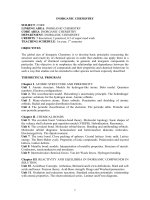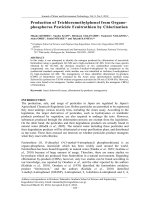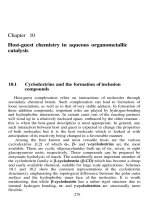Organophosphorus chemistry
Bạn đang xem bản rút gọn của tài liệu. Xem và tải ngay bản đầy đủ của tài liệu tại đây (27.91 MB, 382 trang )
www.pdfgrip.com
www.pdfgrip.com
Organophosphorus Chemistry
Volume 30
www.pdfgrip.com
www.pdfgrip.com
A Specialist Periodical Report
Organophosphorus
Chemistry
Volume 30
A Review of the Literature Published
between July 1997 and June 1998
Senior Reporter
D. W. Allen, Sheffield Hallam University, Sheffield, UK
J. C. Tebby, Staffordshire University, Stoke-on-Trent, UK
Reporters
N. Bricklebank, Sheffield Hallam University, Sheffield, UK
C . D. Hall, King's College, London, UK
T. F? Kee, University of Leeds, UK
M. Salt, Staffordshire University, Stoke-on- Trent, UK
R. Slinn, Staffordshire University, Stoke-on- Trent, UK
J. C. van de Grampel, University of Groningen, The Netherlands
J. S. Vyle, The Queen's University of Belfast, UK
B. J. Walker, The Queen's University of Belfast, UK
RSmC
ROYAL SOCIETY OF CHEMISTRY
www.pdfgrip.com
ISBN 0-85404-324-1
TSSN 0306-0713
0The Royal Society of Chemistry 2000
AN rights reserved
Apart from any fair dealing for the purposes of reseurch or private study, or criticism or review
as permitted under the terms of the UK Copyright, Designs and Patents Act, 1988, this
publication may not be reproduced, stored or transmitted, in any form or by any means,
without the prior permission in writing of The Royal Society of Chemistry, or in the case of
reprographic reproduction only in accordance with the terms of the licences issued by the
Copyright Licensing Agency in the UK, or in accordunce with the terms of the licences issued
by the appropriate Reproduction Rights Organizution outside the UK. Enquiries concerning
reproduction outside the terms stated here should be sent to The Royal Society of Chemistry at
the address printed on this puge.
Published by The Royal Society of Chemistry, Thomas Graham House, Science Park,
Milton Road, Cambridge CB4 OWF, UK
For further information see our web site at www.rsc.org
Typeset by Computape (Pickering) Ltd, Pickering, North Yorkshire, UK
Printed by Athenaeum Press Ltd, Gateshead, Tyne and Wear, UK
www.pdfgrip.com
Introduction
Further changes to our team of authors have taken place. We welcome Terry
Kee (Leeds) and Joe Vyle (Queen’s, Belfast) as new contributors for the areas
of ‘tervalent phosphorus acid derivatives’, and ‘nucleotides and nucleic acids’,
respectively. We hope that they will continue to contribute to future volumes
in this series.
Organophosphorus chemistry continues to be a very active field, the number
of publications showing no sign of decline. Interest in the synthesis of new
phosphines continues unabated, the area still being driven by a need for
improved homogeneous catalyst systems. Perhaps the most unusual reagent
system of the year is the in situ preparation of alane (AlH3), for the reduction
of phosphine oxides to phosphines, by the addition of concentrated sulfuric
acid to lithium aluminium hydride in THF. Also noteworthy is the long
overdue development of a simple procedure for the separation of the mixture
of isomeric phosphabicyclononanes obtained on addition of phosphine to
cyclo-1,5-octadiene. There has also been a resurgence of interest in the
chemistry of the zwitterionic adducts of tertiary phosphines with acetylenic
esters, initially explored more than thirty years ago, and which now have
growing potential as reactive intermediates in synthesis.
Tervalent phosphorus acid derivatives continue to be a focus of activity in
nucleotide chemistry, with many new reagent systems being reported. Studies
related to therapeutic applications continue to dominate nucleic acid and
nucleotide chemistry, with a growing interest in reactions having the potential
for scale-up to the kilogram level, using only limited reagent excesses. Some of
the most rapidly developing areas of research relate to the fabrication of
devices based on surface-immobilised DNA, and the number of publications in
this area looks set to increase significantly.
A notable anniversary in 1997 was the centenary of the birth of George
Wittig. The continued exploitation of the Wittig reaction in the synthesis of a
variety of new biologically active molecules provides a fitting tribute to the
man and his research work. Phosphonium ylides also continue to provide new
challenges for synthetic and structural chemists as illustrated by recent
investigations of their coordination chemistry which have led to a variety of
novel metal complexes involving unusual bonding modes.
Hypervalent phosphorus chemistry, this year, has been dominated by a
series of X-ray crystallographic publications especially in terms of their
systematic study of (a) the formation of hexacoordinated phosphorus compounds via donor interaction and (b) the relevance of this chemistry to
enzymatic intermediates. Other highlights include the preparation of derivaV
www.pdfgrip.com
vi
Introduction
tives of calixarenes containing pentacoordinate phosphorus and the first
corrole derivative containing pentacoordinate phosphorus. A most unusual
compound containing phosphorus in a mixed valence (P1I1-PV-P1I1)chain may
afford entry into a highly novel series of compounds.
Biological aspects of quinquevalent phosphorus acid chemistry, quite separate from nucleotide chemistry, are increasing in importance - tetracoordinate
phosphorus compounds being a major source of transition state analogues for
the generation of abzymes, etc. A wide variety of natural and unnatural
phosphates, especially those of carbohydrates, and their phosphonate and
phosphinate, particularly fluorinated, analogues have been synthesised, usually
with some biologically-related purpose, and the enormous interest in phosphorus analogues of all types of amino acids continues. The importance of
enantiomeric synthesis is illustrated in many of these reports. A recent patent
addresses the reduction of undesirable tastes in foods, pharmaceuticals, etc. by
the addition of phosphates, thiophosphates, and phosphonates, which act as
inhibitors of intramolecular phosphatase enzymes of taste cells. There has been
continuing and increasing interest in approaches to easierkafer nerve gas
hydrolysis (particularly metal cation-catalysed and biological approaches), in
dendrimers, and in both cyclic and acyclic ligands containing phosphorus(V)
acid-functional groups.
In the phosphazene field there have been interesting advances in the main
group chemistry area. Synthetic uses of phosphoranimines (iminophosphoranes) have been extended to the formation of the diazo (N=N) group by their
reaction with NOBF4. Cationic polymerisation of phosphoranimines has been
proven to be a facile tool for the preparation of a large variety of polyphosphazenes. Also notable is the extended use of phosphazene bases as deprotonating agents. As usual, applications of cyclic phosphazenes as flame
retardants receive considerable attention. It has been shown that phosphazene
dendrimers can undergo reactions at internally situated sites as well as at their
surface. The latter reaction mode offers the possibility to synthesise polydendritic macromolecules. The incorporation of cyclophosphazenes into membranes has led to a variety of useful properties. These include removal of
colorants in sugar solutions as well as enantioselective membranes for aminoacids Trp, Phe, and Tyr. The application of phosphazene based polymers in
the biological field is expanding and includes biomaterials, and drug delivery.
Noteworthy is the use of dicarboxylic amino ester substituted polyphosphazenes as carriers for antitumour diamine Pt" complexes. Organic backbone
polymers with pendant cyclophosphazene groups are the subject of various
investigations. Such polymers have the ability to significantly increase the
fluorescence intensity of Eu3+, and a styrene based polymer has been shown to
exhibit a strong selectivity for the extraction of Ag+ ions from aqueous
solution.
The range of physical methods being applied to the study of phosphorus
compounds continues to widen. Thus particle-beam LC-MS was used for
separation of diphosphine-substituted selenido Fe and Ru clusters. A novel
headspace G C method for 'semivolatiles' was utilised for the analysis of butyl
www.pdfgrip.com
Introduction
vii
phosphate and phosphonates. In addition microwave spectroscopy enabled the
detection of the CH2CP radical and FT-ICR mass spectrometry was used to
generate and study stable carbon phosphide anions. There have been renewed
efforts to rationalise phosphorus NMR chemical shifts and there has been a
steady increase in the incorporation of theoretical predictions to aid the
interpretation of results.
www.pdfgrip.com
www.pdfgrip.com
Contents
Chapter 1 Phosphines and Phosphonium Salts
By D. W. Allen
1
1
1
1. Phosphines
1.1. Preparation
1.1.1 From Halogenophosphines and
Organometallic Reagents
1.1.2. Preparation of Phosphines from
Metallated Phosphines
1.1.3 Preparation of Phosphines by Addition
of P-H to Unsaturated Compounds
1.1.4 Preparation of Phosphines by Reduction
1.1.5 Miscellaneous Methods of Preparing
Phosphines
1.2 Reactions of Phosphines
1.2.1 Nucleophilic Attack at Carbon
1.2.2 Nucleophilic Attack at Halogen
1.2.3 Nucleophilic Attack at Other Atoms
1.2.4 Miscellaneous Reactions of Phosphines
12
16
16
18
19
20
2 Phosphine Oxides
2.1 Preparation
2.2 Reactions
2.3 Structural and Physical Aspects
2.4 Phosphine Chalcogenides as Ligands
23
23
24
27
27
3 Phosphonium Salts
3.1 Preparation
3.2 Reactions
28
28
29
4 p,-Bonded Phosphorus Compounds
31
5 Phosphirenes, Phospholes and Phosphinines
36
References
40
Organophosphorus Chemistry, Volume 30
0The Royal Society of Chemistry, 2000
ix
1
4
9
10
www.pdfgrip.com
Cont en ts
X
Chapter 2 Pentaco-ordinated and Hexaco-ordinatedCompounds
By C.D. Hall
59
1 Introduction
59
2 Acyclic and Monocyclic Phosphoranes
60
3 Bicyclic and Tricyclic Phosphoranes
64
4 Pentaco-ordinate/Hexaco-ordinate
Compounds
69
References
Chapter 3 Tervalent Phosphorus Acid Derivatives
By T . P . Kee
74
76
1 Introduction
76
2 Reactions Involving Nucleophilic Phosphorus
76
3 Reactions Involving Electrophilic Phosphorus
82
4 Miscellaneous Reactions
84
References
Chapter 4 Quinquevalent Phosphorus Acids
By B.J. Walker
86
88
1 Introduction
88
2 Phosphoric Acids and their Derivatives
2.1 Synthesis of Phosphoric Acids and their
Derivatives
2.2 Reactions of Phosphoric Acids and their
Derivatives
2.3 Selected Biological Aspects
88
3 Phosphonic and Phosphinic Acids
3.1 Synthesis of Phosphonic and Phosphinic Acids
and their Derivatives
3.1.1 Alkyl, Cycloalkyl, Aralkyl and Related
Acids
3,1.2 Alkenyl, Alkynyl, Aryl, Heteroaryl and
Related Acids
3.1.3 Halogenoalkyl and Related Acids
99
88
95
99
99
99
100
103
www.pdfgrip.com
x1
Contents
3.1.4 Hydroxyalkyl and Epoxyalkyl Acids
3.1.5 Oxoalkyl Acids
3.1.6 Aminoalkyl and Related Acids
3.1.7 Sulfur- and Selenium-containing
Compounds
3.1.8 Phosphorus-Nitrogen Bonded
Compounds
3.1.9 Phosphorus-containing Ring Systems
3.2 Reactions of Phosphonic and Phosphinic Acids
and their Derivatives
3.3 Selected Biological Aspects
4 Structure
References
Chapter 5 Nucleotides and Nucleic Acids
By J.S. Vyle
104
106
108
113
113
115
115
122
123
126
135
1 Introduction
135
2 Mononucleotides
2.1 Nucleoside Acyclic Phosphates
2.1.2. Mononucleoside Phosphate Derivatives
2.1.3. Polynucleoside Monophosphates
2.2 Nucleoside Cyclic Phosphates
136
136
136
142
145
3 Nucleoside Polyphosphates
147
4 Oligo- and Poly-nucleotides
4.1 DNA Synthesis
4.2 RNA Synthesis
4.3 The Synthesis of Modified Oligodeoxynucleotides
and Modified Oligoribonucleotides
4.1.4. Oligonucleotides Containing Modified
Phosphodiester Linkages
4.3.2 Oligonucleotides Containing Modified
Sugars
4.3.3 Oligonucleotides Containing Modified
Bases
157
157
160
5 Linkers
182
6 Interactions and Reactions of Nucleic Acids with
Metal Ions
198
161
161
172
177
www.pdfgrip.com
Contents
xii
7 Nucleic Acid Devices
20 1
8 Nucleic Acid Structures
203
References
205
Chapter 6 Ylides and Related Species
By N. Bricklebank
219
1 Introduction
219
2 Phosphonium Ylides
2.1 Theoretical and Mechanistic Studies of
Phosphonium Ylides and the Wittig Reaction
2.2 Synthesis and Characterisation of Phosphonium
Ylides
2.3 Ylides Coordinated to Metals
2.4 Reactions of Phosphonium Ylides
2.4.1 Reactions with Carbonyl Compounds
2.4.2 Reactions of Aza-Wittig Reagents
2.4.3 Miscellaneous React ions
219
3 Synthesis and Reactions of Phosphonate Anions
235
4 Structure and Reactivity of Lithiated Phosphine
Oxide Anions
238
5 Selected Applications in Synthesis
5.1 Compounds with Potential Biological Properties
5.2 Solid Phase Synthesis
5.3 Tetrathiafulvalenes and Related Organic
Materials
5.4 Synthesis of Miscellaneous Compounds
References
Chapter 7 Phosphazenes
By J. C. van de Grnmpel
1
2
3
4
5
Introduction
Linear Phosphazenes
Cyclophosphazenes
Polyphosphazenes
Crystal Structures of Phosphazenes and Related
Compounds
219
220
223
228
228
232
233
239
239
245
246
247
249
255
255
255
262
269
275
www.pdfgrip.com
...
Contents
xi11
References
284
Chapter 8 Physical Methods
By R. N. Slim and M. C. Salt
291
1 Theoretical and Molecular Modelling Studies
1.1 Studies Based on Semiempirical Methods
1.2 Studies Based on Ab initio and Density
Functional Methods
29 1
29 1
2 Nuclear Magnetic Resonance Spectroscopy
2.1 Biological and Analytical Applications
2.2 Applications of 31PNMR Chemical Shifts
and Shielding Effects
2.2.1 One-coordinate Compounds
2.2.2 Two-coordinate Compounds
2.2.3 Three-coordinate Compounds
2.2.4 Four-coordinate Compounds
2.2.5 Five-coordinate Compounds
2.2.6 Six-coordinate Compounds
2.2.7 Other Nuclei/Multinuclear/General
NMR
2.3 Studies of Equilibria, Configuration and
Conformation
2.4 Spin-Spin Couplings
294
294
292
295
295
296
296
298
300
30 1
303
303
305
3 Electron Paramagnetic (Spin) Resonance
Spectroscopy
307
4 Vibrational and Rotational Spectroscopy
4.1 Vibrational Spectroscopy
4.2 Rotational Spectroscopy
309
309
310
5 Electronic Spectroscopy
5.1 Absorption Spectroscopy
5.2 Fluorescence and Chemiluminescence
Spectroscopy
5.3 Photoelectron Spectroscopy
310
310
31 1
3 12
6 X-Ray Structural Studies
6.1 X-Ray Diffraction (XRD)
6.1.1 Two-coordinate Compounds
6.1.2 Three-coordinate Compounds
6.1.3 Four-coordinate Compounds
6.1.4 Five- and Six-coordinate Compounds
3 12
312
3 12
3 12
313
315
www.pdfgrip.com
Conten ts
xiv
6.2 X-Ray Absorbtion Near Edge Spectroscopy
(XANES)
6.3 Electron Diffraction
315
316
7 Electrochemical Methods
7.1 Dipole Moments
7.2 Cyclic Voltammetry and Polarography
7.3 Potentiometric Methods
316
316
316
3 16
8 Thermochemistry and Thermal Methods
316
9 Mass Spectroscopy
317
10 Chromatography and Related Techniques
10.1 Gas Chromatography and Gas ChromatographyMass Spectroscopy (GC-MS)
10.2 Liquid Chromatography
10.2.1 High-performance Liquid Chromatography
and LC-MS
10.2.2 Thin-layer Chromatography (TLC)
10.3 Capillary Electrophoresis (CE) and Micellar
ElectrokineticChromatography (MEKC)
11 Kinetics
References
Author Index
3 19
319
320
320
321
32 1
32 1
323
331
www.pdfgrip.com
Abbreviations
Benzamide adenine dinucleotide
Cyclodiphospho D-glycerate
Capillary electrophoresis
Creatine kinase
Controlled potential electrolysis
1-(2-chlorophenyl)-4-methoxylpiperidin-2-y1
Cyclic volt ammet ry
cv
DETPA
Di(2-ethylhexyl)thiophosphoric acid
Dimethyl acetylenedicarboxylate
DMAD
Dimethylformamide
DMF
Dimyrist oylphosp hatidylcholine
DMPC
DRAMA Dipolar restoration at the magic angle
Differential scanning calorimetry
DSC
DTA
Differential thermal analysis
Energy resolved mass spectrometry
ERMS
ESI-MS
Electrospray ionization mass spectrometry
EXAFS
Extended X-ray absorption fine structure
FAB
Fast atom bombardment
1-(2-fluorophenyl)-4-rnethoxylpiperidin-2-y1
FPmP
High-performance liquid chromatography
HPLC
LA-FTICR Laser ablation Fourier Transform ion cyclotron resonance
Matrix assisted laser desorption ionization
MALDI
Micellar electrokinetic chromatography
MCE
Mass-analysed ion kinetic energy
MIKE
Polycyclic aromatic hydrocarbons
PAH
Hydroquinone- 0,0’-diacetic acid
QDA
9-[2-(Phosphonomethoxy)et hylladenine
PMEA
S-Acyl-2-thioethyl
SATE
Secondary ion mass spectrometry
SIMS
Spermidine/spermine-N 1-acetylt ransferase
SSAT
Static secondary ion mass spectrometry
SSIMS
Thiazole-4-carboxamide adenine dinucleot ide
TAD
tert - Butyldimet hy lsilyl
tBDMS
Trifluoroacetic acid
TFA
Thermogravimetric analysis
TGA
Thin-layer chromatography
TLC
Time
of flight
TOF
X-Ray absorption near edge spectroscopy
XANES
BAD
cDPG
CE
CK
CPE
CPmP
xv
www.pdfgrip.com
www.pdfgrip.com
1
Phosphines and Phosphonium Salts
BY D. W. ALLEN
1
Phosphines
1.1
Preparation
I . I . I From Halogenophosphines and Organometallic Reagents - The addition
of mesitylmagnesium bromide to phosphorus trichloride in THF at - 78 "C
provides an improved route to tri(mesity1)phosphine (1, R = Me), free of
contamination by the related tetraaryldiphosphine (2, R = Me). However,
applying the same procedure for the synthesis of (1, R = E t ) gave only the
diphosphine (2, R = Et). Related Grignard procedures have also been developed for the synthesis of functionalised mesitylphosphines, e.g., (3)'. Grignard
and organolithium routes to perfluoroalkyl-substitutedtriarylphosphines and
diphosphines, e.g., (4)and (5), have also been developed, the perfluoroalkyl
groups promoting the solubility of related catalytically active metal complexes
in perfluorinated solvent^^.^ and supercritical carbon dioxide4. Sequential
substitution reactions of the amino(ch1oro)phosphines (6) using Grignard and
organolithium reagents provide a route to chiral phosphines which may have
potential for solid phase synthetic procedures5. In a related approach, sequential treatment of phosphorus trichloride with a bulky alkyl Grignard reagent,
followed by methylmagnesium halides, has given the phosphines (7). After
Organophosphorus Chemistry, Volume 30
0The Royal Society of Chemistry, 2000
1
www.pdfgrip.com
2
Organophosphorus Chemistry
protection at phosphorus with borane, these can then be metallated at a
methyl group in the presence of butylithium and (-)-sparteine, and undergo
C-C coupling in the presence of copper(I1) to provide the chiral diphosphines
(8), after deprotection with trifluoroacetic acid6. A range of new menthylphosphine ligands, e.g., (9), has been prepared by the reactions of lithiated
Me
R-P \
Me
(7) R = But, Et3C, I-adarnantyl,
c-C5H9,or c-C6H1
aPR2
R-r-\-Me
Me
(8)
(9) R'
=
PRp2
menthyl, R2 = Ph or menthyl
arylphosphines with bis(menthyl)chlorophosphine7. The reactions of pentamethylcyclopentadienyllithium with phosphorus trihalides have provided the
monohalophosphines (lo), which undergo the expected reactions with reagents
such as methyllithium or lithium aluminum hydride to give related secondary
and tertiary phosphines*. The cyclopentadienylphosphines (1 1) have been
prepared by treatment of dihalogenophosphines with alkylcyclopentadienyllithium reagents. Subsequent quaternisation at phosphorus, followed by
deprotonation of the cyclopentadienyl systems, has given novel phosphoniumbridged alkali- and alkaline earth metallocene complexes, e.g., ( ~ 2 )Lithiation
~.
of iodomethyltriphenylstannane, followed by treatment with a chlorodiorganophosphine, has given the stannylmethylphosphine (13), which has been
converted into the phosphino-stibine (14) by a second lithiation, and the
subsequent reaction with a diorganohalogenostibine''.
+
(10) X
=
CI or Br
Ph3SnCH2PR2'
(13) R' = Cy or Pr'
(1 1) R = Me or But
Rq' PCH2SbR22
(14) R2 = Pr' or But
(12) M"+ = Li+, K+ or Ba2+
0
II
Ph2PCH2C-CH=PPh3
(15)
The phosphinoylide (15) has been obtained by C-lithiation of the related
stabilised ylide and subsequent treatment with chlorodiphenylphosphine' I .
The organolithium-halogenophosphine route has continued to be applied in
the synthesis of ferrocenylphosphines bearing other functional groups12-14,
e.g., (16)13 and (17)14.C-metallation of (1R)-(+)-camphor azine is the key step
in the synthesis of the chiral diphosphine (18)15. Improved routes to pyridylphosphines (e.g., 19), have been developed. The key modification is lithiation
www.pdfgrip.com
1: Phosphines and Phosphonium Sults
3
CHO
I
of a bromopyridine with butyllithium in the presence of TMEDA at low
temperatures, followed by treatment with the appropriate halogenophosphine16. A low temperature halogen-lithium exchange has also been used in the
synthesis of a range of alkoxypyridylphosphines, e.g., (20)17. Treatment of
1,2-bis(dichlorophosphino)ethane with aryllithium reagents has been used in
the synthesis of the new diphosphines, (21)18 and (22)19. Arylation of 1,lbis(dich1orophosphino)ferrocene using organolithium reagents has given a
2
series of new ferrocenyldiphosphines (23). The same group has also reported
an organolithium reagent route to the diphosphines (24)20.This approach has
also been used in the synthesis of the chiral ferrocenyldiphosphines (25)2’,the
1,8-bis(phosphino)naphthalenes (26)22,and in an improved large scale route to
2,2’-bi~(diphenylphosphino)diphenylmethane~~.
A wide range of functionalised
&PPh2
%
PPh2
Ar2P
PAr2
(24) Ar = 0-tolyl,
X = H,H or CMe2
R.-2
NMe2
(25) R = Me, Pent
or Ph
(26) R = Me, Pr‘,
Cy or Ph
www.pdfgrip.com
4
Organophosphorus Chemistry
phosphines has also been prepared by the organolithium-halogenophosphine
route, including the arylazophenylphosphine (27)24, the heterocyclic system
(28)25, the phosphinoaminoalcohol (29)26, the phosphinoacyloxazolidinone
(30)27, the chiral aminophosphines (3 1)28 and the phosphinophenols (32)29.
Phosphines functionalised with crown ether groups (33)30 and related N ,Smacrocyclic systems, e.g . , (34)3l , have also been prepared by conventional
organolithium-halogenophosphine routes.
(31) R = Me or Et
Ph2P
3-X
(33) x = O , 1 or2, R = H o r M e
(34)
A ‘microreview’ of the use of organozinc reagents in the synthesis of
functionalised phosphines has appeared3*. The reactions of organozirconium
reagents (formed by addition of dicyclopentadienylzirconium(ch1oro)hydride
to vinyl- and allyl-silanes) with chlorophosphines have been used in the
synthesis of silylalkylphosphines, e.g., (35)33.In a similar vein, cycloaddition of
dicyclopentadienylzirconium to vinyl- and alkynyl-phosphine oxides, followed
by treatment with a dichlorophosphine, provides a novel one-pot route to
mono or bicyclic phosphiranes, e.g., (36), and phosphirenes, e.g. (37)34.
1.1.2 Preparation of Phosphines from Metallated Phosphines - The displacement of halogen, commonly fluorine, from aromatic and heteroaromatic
(35) n = 0, 1 or 2; x = 0 or 1
www.pdfgrip.com
5
1: Fhosphines and Phosphonium Salts
substrates, using metallophosphide reagents, has been widely employed in the
past year in the preparation of a range of new systems. Among heteroarylphosphines prepared in this way are the ‘two-layer’ chiral quinolylphosphine (38)35,
the phosphinoterpyridyl (39)36, and the diphosphinoacridine (40, X = N)37.
1)isplacement of fluorine from benzenoid systems has been the method of
choice for the diphosphinoanthracene (40, X = CH)38, phosphines bearing
chiral oxazolinyl systems, e.g., (41)39, the phosphonate-functionalisedphosphines (42)40,and a wide range of functionalised, amphiphilic phosphines, e.g.,
(43>41,The generation of alkynylphosphide reagents by treatment of elemental
phosphorus with an alkynyllithium, followed by addition of an alkyl halide,
has been used as a route to alkynylphosphine~~~.
Further examples of ring
opening of three- and four- membered cyclic ethers and thioethers by
Me
Ph
I
Ph2Pe!(OR)2
(42) R = Et or Pri
phosphide reagents have been reported. The reaction of lithium diphenylphosphide with cyclohexane epoxide provides a one-pot route to the chiral,
ftinctionalised, phosphine (44)43. A related ring-opening of a,P-epoxysilanes,
followed by quaternisation of the initially formed phosphinosilane with
iadcimethane, and a subsequent Peterson elimination, results in the formation
of vinylphosphonium salts4. The reagent (45) is formed on treatment of
tl-iiirane with lithium diphenylphosphide, and has found use for the synthesis
of new polydentate, mixed donor ligands, e.g., (46)45. Phosphide-induced ringopening of functionalised oxetanes has been used in the synthesis of a range of
mixed donor, tripod-like, phosphine l i g a n d ~ ~e.g.,
~ - ~(47)48.
~ , The phosphinomethyloxetane (48), prepared by a conventional mesylate-lithium diphenylphosphide route, has been shown to undergo aminolytic cleavage, leading to
other types of functionalised, mixed donor, tripod ligands, e.g., (49)49. The
www.pdfgrip.com
Organophosphorus Chemistry
6
yiz p
Ph2PnS
<2
PPh2
(47)
Li
(48)
NEt2
(49)
Ph2P
OSO3Li
(50) R1,R2 = H or Me,
n = 1 or 2
ring-opening of cyclic sulfate esters by phosphide reagents has provided a new
route for the synthesis of amphiphilic and water-soluble ligands, e.g., (50)50.A
31PNMR study of the cleavage of 5-phenyldibenzophospholewith lithium in
THF at 20 "C has shown that the resulting 5-lithiodibenzophospholide reagent
exists as an apparent complex with the other cleavage product, phenyllithium,
having lj3'P= 15 ppm. This complex is only destroyed on heating under reflux
in the presence of t-butyl chloride, to give the free lithiophospholide, having
lj3'P= 0.5ppmsl. This reagent has found use in the synthesis of the new chiral
diphosphines (5 lyl and (52y2.Lithium-cleavage of the triphosphines (53) has
provided triphosphide reagents which have been used in the synthesis of the
new chiral, tripod ligands (54)53. The reaction of a diarylphosphide reagent
obtained by deprotonation of the related diarylphosphine with lithium disopropylamide, with the trihalide CH3C(CH2Br)3, has been employed in the
synthesis of the triphosphine (55)54. Among other phosphines prepared via the
4
R
p
A
r
2
'-PAr2
PAr2
(53) R = H or Ph
Rl
PArR2
(54) R' = H or Ph, R2 = alkyl
PAr2
(55)Ar = mCF3C6H4
use of lithiophosphide reagents are the bipyridyl (56)55,the diphosphinobutadiene (57)56,and the aminophenylphosphine (58), from which new multidentate P, As, N ligands have been derived57. Lithium diphenylphosphide has
found use for the demethylation of arylmethyl ethers5g. Metallophosphide
reagents have also found extensive use for the synthesis of compounds
involving bonds from phosphorus to boron, silicon, or tins9-65.
www.pdfgrip.com
1: Phosphines and Phosphonium Salts
f
7
PPh2
Although not as popular as the lithium analogues, sodium- and potassiumorganophosphide reagents continue to be employed in phosphine synthesis.
Reactions of sodioorganophosphide reagents with alkyl halides and alkyl
sulfonate esters have found use in the synthesis of the new chiral systems (59)66,
(60)67,and (61)68,and also for the chiral polydentate ligand (62)69.Attempts to
prepare o-chloroalky(pheny1)phosphines (63) from the reactions of monosodiumphenylphosphide with a,w-dichloroalkanes met with only moderate
success, with several other products being formed70.A route to alkylcyclopolyphosphines is provided by the reaction of red phosphorus with metallic sodium
in dimethoxyethane, followed by treatment of the resulting sodium phosphide
.
Ph2P
(59) R = Me or Pr'
(60)
OMe
PPh2
reagent with alkyl halides71. The phosphide reagent (64) has been used in the
synthesis of a range of diphosphines bearing the 3,5-bis(trifluoromethyl)phenyl
substituent, e.g., (65)72. Potassium diphenylphosphide was the reagent of
choice for the synthesis of the chiral amidinoalkylphosphine (66)73, and the
aminlophosphine (67), although development of the latter system was frustrated
by the formation of aziridines in the reactions of precursor aminoethyl
tosylates with the p h ~ s p h i d e ~Deprotonation
~.
of a borane-protected chiral
secondary phosphine with potassium t-butoxide has given a protected phosphide: reagent which has been used in a conventional reaction with a haloalkane
to give the chiral system (68)75. Deprotonation of phosphine or primary
phosphines under superbase conditions (DMSO-KOH), followed by treatment
with bis(chloroethyl)amines, has given a route to the phosphines (69)76.









